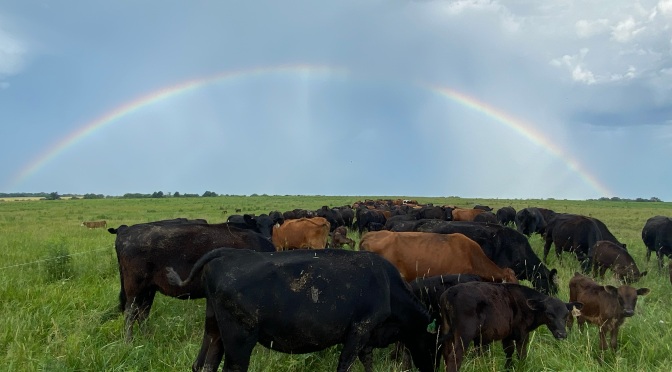As blogged before, since changing to Real Wealth Ranching protocol which not only teaches a change in grazing management, but includes other changes which i believe will make my life easier as well as being more profitable all the while building soil, forage, and animal health.
One of the main precepts of any grazing management is observation of stock condition. If the livestock are suffering under your management, you must change something immediately. Daily or, at least often, observation of body condition, manure consistency, thriftiness, and overall general health including appropriate hair shedding, bright eyes, well hydrated, being alert, calm cud chewing, not bawling or wandering, and ears up demeanor are a few subtle clues to health.
For good reason, up until this year, i’ve set my calving season from 15 April to 31 May. For me, personally, that is not a good time because breeding season is 7 July to 20 Aug and 100% of the time, mid August to late September is high ragweed season which is debillitating to me making it nearly impossible to remove the bulls to keep defined dates for calving season.
However, this year (2022), i’m pushing that back to 15 May thru 30 June, With the change to total grazing and by default and plan i am offering a better balance protein/roughage diet to both cows and calves and hope to avoid the serious scours (calf losses about 30% for a couple years running!) encounter by earlier calving. However, calving that early in north central Missouri has its downsides in that it often can be extremely cold and muddy, plus cows will not be in best condition coming out of winter before calving.
Pushing it back a month means I avoid the beginning and ending of ragweed season. The animals need to be nearly set stocked during that time because i cannot be outside.
However, the final decision was to turn out the bulls on 22 July and will plan a 60 day breeding season. Most will likely breed in the first 35-40 days anyway, but the few which are later may allow me to grow my herd a bit. This is a calving season of 1 May to 1 July. However, the bigger benefit will be that removing the bulls will be after allergy season. By keeping my own replacements, there is a much greater chance of success by having adapted animals to my particular environment. Purchasing stock is a crapshoot at best.
As calving season has come along this spring (2022), I’ve really enjoyed noticing the HUGE difference in condition of cows which calved early/mid April and those few which have calved mid May. Any cow which calved early is very slow to recover from calving and has not shedded out well at all. Will that affect rebreeding? In the past, it has not, but the cows sure look better and are carrying much more weight.
One thing that has given me considerable concern is the number of open cows this spring that were pregnancy checked as being bred last fall. Young cows and really good 8 and 9 year olds have lost. In other words, it’s not been any particular age group or any specific bloodlines. Still pouring over records to see what might have caused this. It was about 5% abortion/fetal loss last year which the vets say is on the upper limits of normal. This year’s percentage is hovering around 7% abortion/fetal loss. This despite giving my cows a Lepto shot last fall, which is not what i usually do. However, a couple of those are purchased cows/heifers which are often not adapted to my environment.
The typical death loss of 1% to 2% sadly hit that upper percentage point this year to some sort of chronic wasting disease, most likely anaplasmosis. Seems like it hits my 3-6 year old good doing cows. Unfortunately, this seems to be just a part of raising livestock.
I’m continuing the Real Wealth Ranching protocol and total grazing plan because it has been an amazing program. Coming up on my second full year of implementation here in a few months. I tell people all i’m doing is providing landscaping tools and my cows do the work (grazing). Well, they don’t run the chainsaw.























